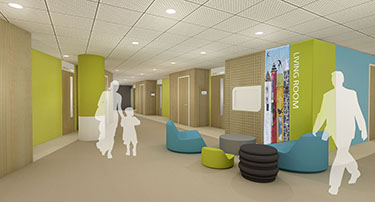|
Subscribe / Renew |
|
|
Contact Us |
|
| ► Subscribe to our Free Weekly Newsletter | |
| home | Welcome, sign in or click here to subscribe. | login |
Construction
| |
 |
July 24, 2014
Seattle Children’s psychiatry unit will help kids feel at home
ZGF Architects

Rossen
|
Perhaps no health care environment has the potential for direct influence on positive outcomes more than pediatric inpatient behavioral health. It’s not something most people typically think about every day.
According to a report by the Centers for Disease Control and Preventions, 13 to 20 percent of children living in the United States experience a mental disorder in a given year, and the prevalence of these conditions is increasing.
The state of Washington has fewer than 100 inpatient beds for this underserved patient population. Until recently, the 20-bed unit at Seattle Children’s was one of the only specialized options for inpatient psychiatric support and the only option for inpatient support for adolescent eating disorders in the state.
Seattle Children’s is currently undergoing a renovation to create a 41-bed Psychiatry and Behavioral Medicine Unit to serve kids ages 3 to 18 across a broad spectrum of diagnoses, including autism, ADHD and eating disorders. The unit will open in the spring of 2015.
The design of the new unit creates an opportunity to look at innovative operational and environmental improvements to support an improved model of care for the treatment and support of these patients and their families.
The Center for Health Design reports that little attention has been focused on the role of the physical environment in behavioral health settings while studies have shown that the quality of the interior environment can have a profound effect on the psyche and even reduce the number of patients who need to be restrained.
Health care designers and planners have understood the positive effects of creating nurturing and supportive interior environments for some time. What makes a behavioral health unit different? Quite a lot, it turns out.
A safe place for kids
The design focus for the new behavioral health unit at Seattle Children’s is on creating restorative, energized spaces laid out similar to the rooms of a house. This variety of spaces allows for choices and variation to replicate and normalize daily activities.
Patients awake in private rooms with modern amenities including a space for parents to spend the night. Bedrooms are grouped around a living room with soft, sculptural and colorful furnishings, movies and games that encourage social interaction, and a safe place for kids to start and end their day, much like a home.
Daytime activities include day rooms for age-specific structured time, a classroom with cubbies for books, white boards, laptops and an integrated art wall to display patients’ creations. There is also an indoor gym with yoga mats, exercise balls and equipment, and a bouldering wall to encourage kids to move their bodies, gain confidence and practice team-building social skills.
Perhaps the most important aspect of the design is not what the space has, but what it doesn’t. The interior environment is designed to look seamless, with safety precautions and tools integrated into the design in a discreet manner so that they do not become the focal point of the space.
Eliminating plastic-glass cover panels and heavy-duty bolts to secure items to the wall and cabinetry does as much to soften and humanize the space as any other single design element. The walls are clad with natural wood for warmth and texture, and durable panels, routed, etched and painted in bright pops of color to protect the interior environment, provide wayfinding and integrate art.
These design elements eliminate the potential for self-injury while also reducing the potential for harmful behavior by introducing elements of nature and art to reduce stress and aggression. Lighting was also carefully selected to minimize the look of durability and emphasize playful shapes, the calming qualities of defused light and natural light wherever possible. Throughout the unit, great effort was taken to connect patients to natural daylight, or when not possible, to use LED lighting and design elements to bring a sense of the outdoors in.
Pops of color
You might think that a psychiatric environment should use muted, calming colors. In fact, color and movement play an important role in the therapeutic process.
According to the book “Color, Environment and Human Response” by Frank H. Mahnke, color in the built environment has a far more integral role to play psychologically and physiologically than just positive distraction. The ability to focus and engage is affected and enhanced by the use of bright color, art and sculptural elements.
At Seattle Children’s, color is used as placemaking, providing clarity to the wayfinding and variety to the day’s activities. Colorful furnishings provide pops of contrasting color and sculptural playfulness to the spaces. Groupings of seating within the unit are as striking as a modern sculpture as they are durable and functional. The classically designed Panton chair by Verner Panton and stylized lounge seating is indestructible yet the material is soft in contrast to the more commonly prescribed hard, molded plastic variety.
Seattle Children’s recognizes the important role families play in the quality of outcomes for patients. With this mind, great care was taken to support families and encourage their engagement in the treatment process.
Family respite spaces, both inside and outside patient rooms allow families to stay overnight with their children, dine inside the unit, check in with work, meet with extended family and gain information and education from the care team. Amenities include a family kitchen, computers, flat-screen TVs, secured storage for personal belongings and comfortable furnishings. These family rooms provide a place for families to step out for a minute or an hour to recharge themselves.
The role of design of the new Psychiatry and Behavioral Medicine Unit at Seattle Children’s is to support high-quality teams, to enhance the odds of success, minimize stress and improve safety. The goal of bringing kids and families to wholeness and maintaining positive and supportive experiences for everyone who enters the space, and allowing perceptions to change while providing a sense of hope that all kids have a chance to feel safe and cared for is well worth the extra effort and persistence in design.
Anita Rossen is a principal and senior interior designer with over 15 years of experience creating functional and innovative interior environments.
Other Stories:
- How lean helped hyper-fast project to cross the finish line
- What’s next for the UW medical center
- Student health centers evolving to provide more holistic care
- Behavioral health projects present unique challenges
- How to design and build a plastic surgery center in less than 5 months
- Hospitals have a lot to learn from lean
- You can protect patients with clean construction



